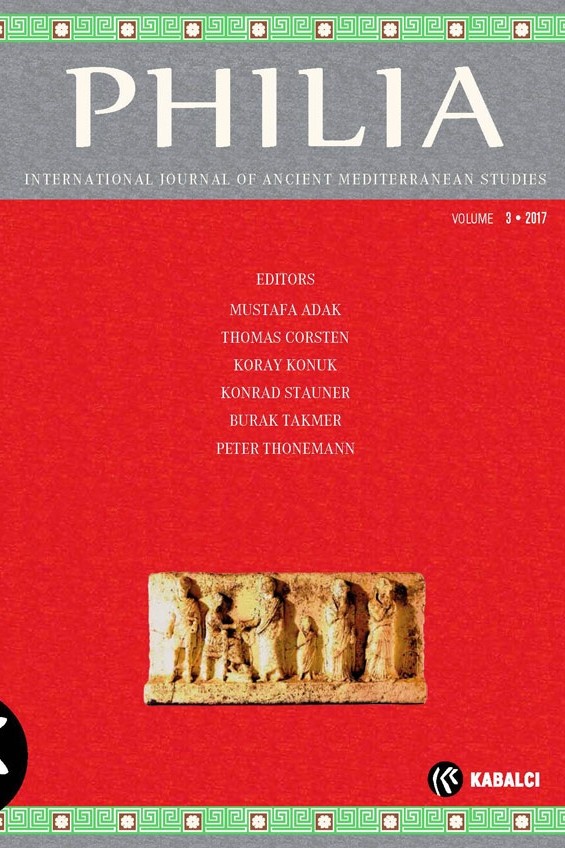Hüyüklü’den (Pisidia Antiokheia) Yazıtlar
Pisidia Antiokheia, Hüyüklü, Cn. Dottius Plancianus, kent patronu, mezar yazıtları
Les inscriptions d’Antioche de Pisidie à Hüyüklü
Pisidian Antioch, Hüyüklü, Cn. Dottius Plancianus, city patron, epitaphs,
___
- Burrell 2004 B. Burrell, Neokoroi. Greek Cities and Roman Emperors, Leiden-Boston 2004 (Brill, Cincinnati classical Studies, New Series IX).
- Byrne – Labarre 2006 M. A. Byrne – G. Labarre, Nouvelles inscriptions d’Antioche de Pisidie d’après les Note-Books de W. M. Ramsay, Bonn 2006 (IK 67).
- Calder 1912 W. M. Calder, Colonia Caesareia Antiocheia, JRS 2, 1912, 79–109.
- Campanile 1994 D. M. Campanile, I sacerdoti del koinon d’Asia (I sec. a C. – III sec. d. C.): contributo allo studio della romanizzazione delle elites provinciali nell’Oriento greco, Pisa 1994.
- Christol – Drew-Bear 2007 M. Christol – Th. Drew-Bear, P. Anicius Maximus, légat du proconsul d’Afrique M(anius) Acilius Glabrio, et les grandes familles d’Antioche de Pisidie, Anatolia Antiqua XV, 2007, 225–232.
- Christol – Drew-Bear 2012 M. Christol – Th. Drew-Bear, De la notabilité locale à l’ordre sénatorial. Les Flavonii d’Antioche de Pisidie, in: S. Demougin – J. Scheid (edd.), Colons et colonies dans le monde romain, Rome 2012, 179–218 (Collection de l’École Française de Rome 456).
- Jacques 1984 F. Jacques, Le privilège de liberté. Politique impériale et autonomie municipale dans les cités de l’Occident romain (161–244), Rome 1984 (Collection de l’École Française de Rome 76).
- Levick 1967 B. Levick, Roman Colonies in Southern Asia Minor, Oxford 1967.
- Mitchell – Waelkens 1998 S. Mitchell – M. Waelkens, Pisidian Antioch. The Site and its Monuments, London 1998.
- Ramsay 1916 W. M. Ramsay, Colonia Caesareia (Pisidian Antioch) in the Augustan Age, JRS 16, 1916, 83–134.
- Ramsay 1930 W. M. Ramsay, Anatolicae quaedam – VIII. Street Signs in Anatolian Cities, JHS 50, 1930, 272–274.
- Robert 1940 L. Robert, Les gladiateurs dans l’Orient grec, Paris 1940 (réimpr. Amsterdam, A. M. Hakkert 1971).
- Robinson 1925 D. M. Robinson, Notes on Inscriptions from Antioch in Pisidia, JRS 15, 1925, 253–262.
- Rossner 1974 M. Rossner, Asiarchen und Archiereis Asias, Studii Classice XVI, 1974, 101–142.
- Sterrett 1888 J. R. S. Sterrett, The Wolfe Expedition to Asia Minor, Papers of the American School of Classical Studies at Athens, vol. III, 1884–1885, Boston 1888.
- Zgusta 1964 L. Zgusta, Kleinasiatische Personennamen, Prague 1964 (Verlag der Tschechoslowakischen Akademie der Wissenschaften).
- ISSN: 2149-505X
- Başlangıç: 2015
- Yayıncı: Kabalcı Yayıncılık
Phrygia’da bir İmparator Azatlısı’nın Adak Yazıtı
Dünyanın En Eski Şanzıman Tasviri. Phrygia Hierapolisi’nden «Daedalos» ve Mucit Ammianos
Bithynia’da «Ünlü Cassius’lar»
Roma Gümrük Sisteminde Contrascriptores
Bir parthenos’un Yaşı. Aphrodiasias’tan yeni bir Mezar Yazıtı
Küçük Asya’da Diadokhoi Savaşları: Kardia’lı Eumenes’in Savaş Stratejisi
Dorylaion’dan Meter İçin Yeni Bir Adak Yazıtı
Contantinus’a ait Ticinum Madalyonu ve Üç-Tanrılı Brakteat’ların Kökeni
Herakleia Pontike’li Historiograflar ve Eserleri
